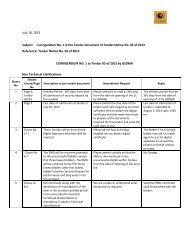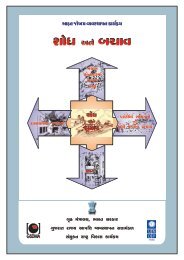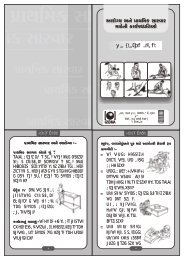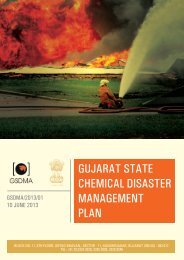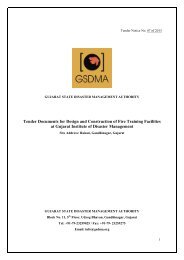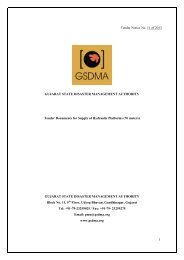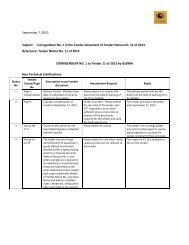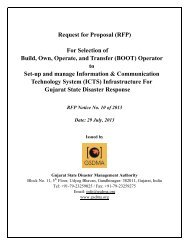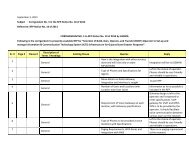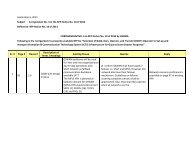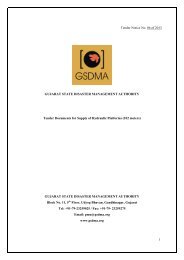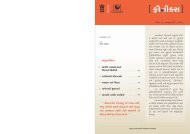Emergency Response Guidebook - Gujarat State Disaster ...
Emergency Response Guidebook - Gujarat State Disaster ...
Emergency Response Guidebook - Gujarat State Disaster ...
Create successful ePaper yourself
Turn your PDF publications into a flip-book with our unique Google optimized e-Paper software.
GUIDE160Halogenated SolventsERG2012ERG2012Halogenated SolventsGUIDE160POTENTIAL HAZARDSHEALTH• Toxic by ingestion.• Vapours may cause dizziness or suffocation.• Exposure in an enclosed area may be very harmful.• Contact may irritate or burn skin and eyes.• Fire may produce irritating and/or toxic gases.• Runoff from fire control or dilution water may cause pollution.FIRE OR EXPLOSION• Some of these materials may burn, but none ignite readily.• Most Vapours are heavier than air.• Air/Vapour mixtures may explode when ignited.• Container may explode in heat of fire.PUBLIC SAFETY• CALL EMERGENCY RESPONSE Telephone Number on Shipping Paper first. If Shipping Paper notavailable or no answer, refer to appropriate telephone number listed on the inside back cover.• As an immediate precautionary measure, isolate spill or leak area for at least 50 meters (150 feet) inall directions.• Keep unauthorized personnel away.• Stay upwind.• Many gases are heavier than air and will spread along ground and collect in low or confined areas(sewers, basements, tanks).• Keep out of low areas.• Ventilate closed spaces before entering.PROTECTIVE CLOTHING• Wear positive pressure self-contained breathing apparatus (SCBA).• Wear chemical protective clothing that is specifically recommended by the manufacturer.• Structural firefighters’ protective clothing will only provide limited protection.EVACUATIONLarge Spill• Consider initial downwind evacuation for at least 100 meters (330 feet).Fire• If tank, rail car or tank truck is involved in a fire, ISOLATE for 800 meters (1/2 mile) in all directions;also, consider initial evacuation for 800 meters (1/2 mile) in all directions.EMERGENCY RESPONSEFIRESmall Fire• Dry chemical, CO 2 or water spray.Large Fire• Dry chemical, CO 2, alcohol-resistant foam or water spray.• Move containers from fire area if you can do it without risk.• Dike fire-control water for later disposal; do not scatter the material.Fire involving Tanks or Car/Trailer Loads• Fight fire from maximum distance or use unmanned hose holders or monitor nozzles.• Cool containers with flooding quantities of water until well after fire is out.• Withdraw immediately in case of rising sound from venting safety devices or discoloration of tank.• ALWAYS stay away from tanks engulfed in fire.SPILL OR LEAK• ELIMINATE all ignition sources (no smoking, flares, sparks or flames in immediate area).• Stop leak if you can do it without risk.Small Liquid Spill• Take up with sand, earth or other non-combustible absorbent material.Large Spill• Dike far ahead of liquid spill for later disposal.• Prevent entry into waterways, sewers, basements or confined areas.FIRST AID• Move victim to fresh air.• Call 108 or emergency medical service.• Give artificial respiration if victim is not breathing.• Administer oxygen if breathing is difficult.• Remove and isolate contaminated clothing and shoes.• In case of contact with substance, immediately flush skin or eyes with running water for at least 20minutes.• For minor skin contact, avoid spreading material on unaffected skin.• Wash skin with soap and water.• Keep victim warm and quiet.• Ensure that medical personnel are aware of the material(s) involved and take precautions to protectthemselves.Page 260Page 261



